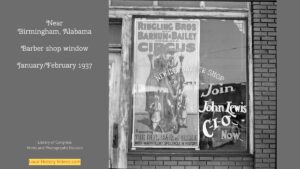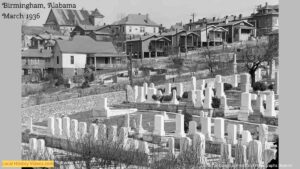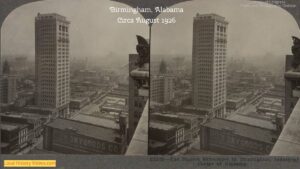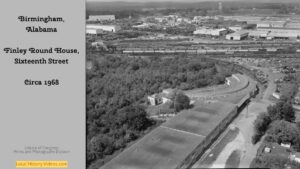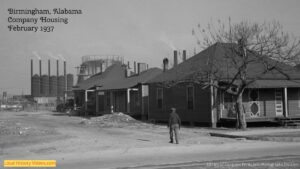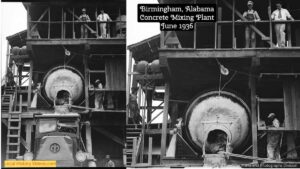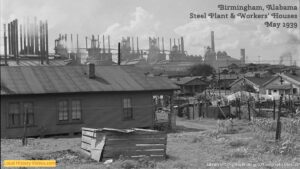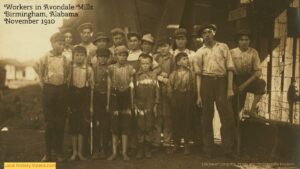Step back in time to 1930s Birmingham, Alabama, a vibrant city struggling with the impact of the Great Depresssion.
1930s America
In 1937, seventeen million Americans were unemployed in the USA.
It was also the year the patent for Nylon was granted.
Kraft Macaroni & Cheese Dinner, Smarties, Spam, Krispy Kreme Doughnuts, Kix cereals, and Spam luncheon meat were introduced.
The German airship Hindenburg burst into flame when mooring to a mast in Lakehurst, New Jersey.
Walt Disney’s Snow White and the Seven Dwarfs, the first feature-length animated cartoon with color and sound, opened in Los Angeles.
NBC & RCA sent the first mobile-TV vans onto the streets of New York.
In California, the Golden Gate Bridge opened to traffic and pedestrians.
The New London School in New London, Texas, suffered a catastrophic natural gas explosion, which killed 295 students and teachers.
This was the year that Morgan Freeman, Jack Nicholson, and Warren Beatty were born.

The Steelworks
At its peak, Birmingham’s steelworks employed tens of thousands of workers, reflecting the city’s critical role in the industrial landscape of the American South. The workforce numbers fluctuated based on economic conditions and market demand, peaking during times of high production needs, particularly during the World Wars.
The steelworks not only employed thousands directly but also created numerous ancillary jobs in related fields, including transportation, maintenance, and manufacturing of steel products. The growth of the steel industry was a significant factor in Birmingham’s population increase during this period, as workers migrated to the city in search of job opportunities.



However, this remarkable growth came with its challenges: labor disputes, environmental concerns, and the health impacts on workers. Today, as we reflect on Birmingham’s rich industrial past, we’re reminded of both its successes and struggles.
The Concrete Industry
Birmingham’s rapid industrialization in the late 19th and early 20th centuries created a substantial demand for construction materials, including concrete. As the city grew, large-scale construction projects—such as roads, bridges, and buildings—became necessary to accommodate the increasing population and economic activity. The availability of local materials, including gravel, sand, and cement, facilitated the concrete mixing process, making it a viable choice for builders in the region.

Miners Homes

The Roadside Stand
“Honest Weights, Square Dealings”. In 1936, this roadside stand offered Catfish, Trout, Perch, Drum, Buffalo, Eel, and lots of delicious, fresh fruits.

More about Alabama
- Labor Rights in Old Birmingham, AlabamaThe labor movement in Birmingham, Alabama, has been a significant part of the city’s industrial history, characterized by a struggle for workers’ rights, labor organization, and social justice.
- Birmingham, Alabama in the 1930sStep back in time to 1930s Birmingham, Alabama, a vibrant city struggling with the impact of the Great Depresssion. 1930s America In 1937, seventeen million Americans were unemployed in the USA. It was also the year the patent for Nylon was granted. Kraft Macaroni & Cheese Dinner, Smarties, Spam, Krispy Kreme Doughnuts, Kix cereals, and… Read more: Birmingham, Alabama in the 1930s
- Birmingham, Alabama in 1926By 1926, Birmingham, Ala., was at the height of its industrialization and a dynamic, modern place to be.
- The Finley Roundhouse at Birmingham, AlabamaThe Finley Roundhouse was an important part of railway history in Birmingham, Alabama. Abandoned and derelict, its roof was destroyed by a hurricane.
- Company Housing in Old Birmingham, AlabamaAs workers migrated into the expanding city of Birmingham, Alabama the company houses were in high demand.
- Making Concrete in Old Birmingham, AlabamaConcrete was an essential part of growing the city and industries of Birmingham, Alabama.
- The Steel Industry in Birmingham, AlabamaDiscover why steel was such an important part of the local economy in Birmingham, Alabama, USA.
- Old Photos of the Workers of Mobile, AlabamaGlimpse history through old photos of adults and children at work in Mobile, Alabama, USA.
- The Child Workers of Birmingham, AlabamaDiscover the haunting old photos of children who worked in the factories, eateries, messaging and transportation industries of Birmingham, Alabama.
- Old Images of Mobile, AlabamaGlimpse history through old images of Mobile, in Alabama, USA.


